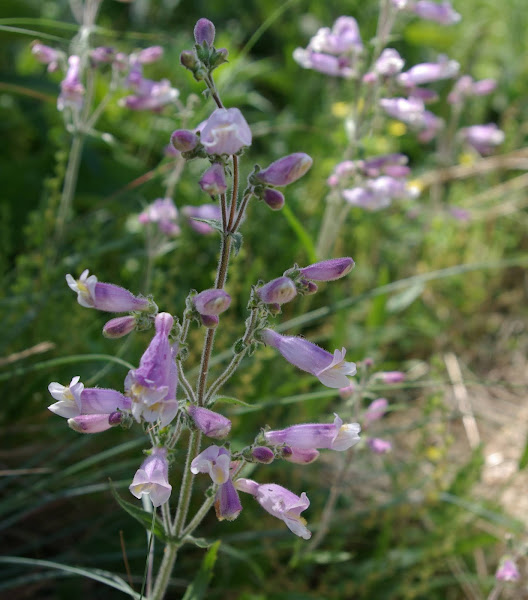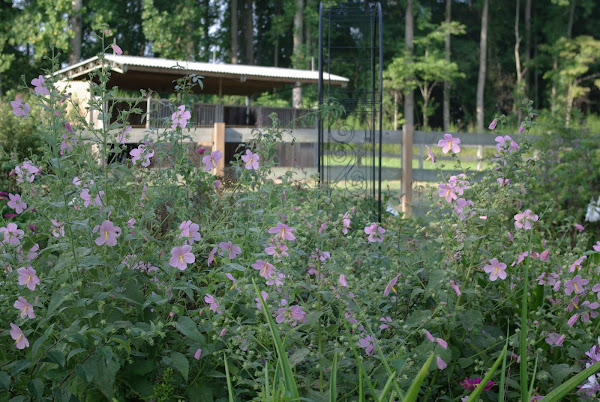Late December is a time for looking back and assessing the year past, so here is a roundup of the natives blooming in my garden throughout the year. The earliest of the natives may be the blue violet simply because she seems to bloom, at least a little bit, almost every month of the year.
Toothwort, whose rhizomes the voles luckily don't seem to care much for. This is an especially robust and floriferous form from Niche Gardens, now sadly closed.
The lovely and very sweetly fragrant woodland phlox. Rather picky about consistent moisture levels though, and while evergreen, only seems to grow just before it blooms in my garden.
Bluestar (Amsonia tabernaemontana?), found growing wild on the farm. I transplanted some of it into the garden.
A wild geranium found beside one of the pastures. It's been divided endless times for the garden now.
A native crabapple (Malus angustifolia), one of three growing in the floodway field and near the creek. I have tried without success to grow it from the fruit. I don't think I was patient enough. not only are the flowers beautiful, they are sweetly fragrant like those of its relative the apple tree.
If you have a wet sunny corner, I would recommend planting American Snowbell. For fragrance I think the only tree that rivals it is Japanese flowering apricot. To me the scent reminds of our white mystery iris, Hubrecht's amsonia, and the rose Veilchenblau. I cannot tell you if it is like violets because everything that is supposed to smell like a violet (including Viola odorata) has no fragrance to me, and I can't remember exactly what lily of the valley smells like.
Hoary mountain mint attracts a lot of pollinators. I bought it after reading about how much pollinators love mints in a seed catalog from the NC Botanical Garden and Niche Gardens. From the Niche Gardens catalog: "Foliage reaches about 3' in height by midsummer, with upper leaves starting to take on a cool and silvery appearance. Flowers follow in multi-layered tiers of silvery white blooms. Bees, butterflies and some pollinators you"ve never laid eyes on come to sip the minty nectar: Mountain Mint attracts an incredible assortment of insects."
Hibiscus moscheutos, a plant that the Japanese beetles love as much as I do but it's still showy anyway. A version with smaller flowers grows next to the creek and in the sloughs on our farm.
Sweet pepperbush grows wild here all over the farm, and prominently around the old house site and near the big perennial bed. It is a wetland plant that somehow seems impervious to drought and when it blooms in July attracts every pollinator around, the sweet perfume wafting a long distance.
The ultimate butterfly magnet alongside butterfly bush and our native cup plant, Joe Pye Weed. This grows wild on our farm, sometimes in standing (but not stagnant) water, and I have transplanted some into the garden and it has volunteered next to the horses' stalls.
Seashore mallow is kind of a picky plant to grow. Lots of moisture but not too wet, and a lot of food. If it gets too dry it never fully recovers. I grow it anyway because it's incredibly beautiful when it's happy, especially first thing in the morning, it's something brand new near the end of summer, and it's immensely popular with swallowtail butterflies, hummingbirds and bees.
As always Bidens is the star of September. It already grew wild here and I was familiar with it before from seeing it in fields and ditches when we drove to Jordan Lake and when I drove to my job at Duke University. It forms spectacular masses of blooms that are always abuzz with pollinators.
This unknown aster (lavender frost aster, early willowleaf aster?) popped up in my garden.
Aromatic aster
Aster 'Miss Bessie' rounds out the aster season, often not blooming until after Halloween and sometimes continuing until December. Pollinators of every sort flock to this plant as this and groundsel trees are the only things consistently in bloom that time of year. Thank you Gail for hosting Wildflower Wednesday.

















































Wow! What a display of flowers you have throughout the year, sweetbay. I love the flowering trees, which are relatively few and far between here. Of course, anything that likes damp, not to mention continuously moist, soil is doomed in my climate.
ReplyDeleteThank you Kris. I have to confess I wish it was a good bit drier here right now. We got 6 1/2 inches in one go in mid-November from a tropical depression and the ground has been soaked ever since. Nothing can dry out, and we keep getting wave after wave of rain since then. I wish I could give you some of ours, California needs it so much more than we do.
DeleteOh, I love this! So many of these are dear, favorite, familiar plants. A beautiful post for Wildflower Wednesday. :)
ReplyDeleteThank you Beth!
DeleteWhat a beautiful post with all my favorites, many I sure wish would grow at Clay and Limestone. Happy Holidays and WW! xogail
ReplyDeleteThank you Gail, your concern for native insect life has rubbed off on me, and providing a habitat for all sorts of animals is a reward in of itself for gardening. Happy Holidays to you too!
DeleteWhat a wonderful year round nectar buffet! And fabulous insect photos, too. Interesting what you said about the scent of flowers. I can smell violets, but there are so many other, supposedly fragrant flowers, that evades my nose almost completely. How we perceive scents is so incredibly varied and personal...
ReplyDeleteThank you Anna. I agree that our perception of scents is very varied. My husband thinks I have a keen sense of smell but there are scents he can detect that I can't and vice versa. I can't detect any fragrance from Moonflowers for example, but G. says they have a fresh scent like the beach.
ReplyDeleteSo beautiful! Such lovely colours. I love all those bees and butterflies. :)
ReplyDeleteThank you!
DeleteYour post is making me think of spring even more than I already am. Here is so cold, but looking forward to the blooming season. Thank you for brightening my day with your beautiful photos.
ReplyDeleteThank you Angie.
Delete